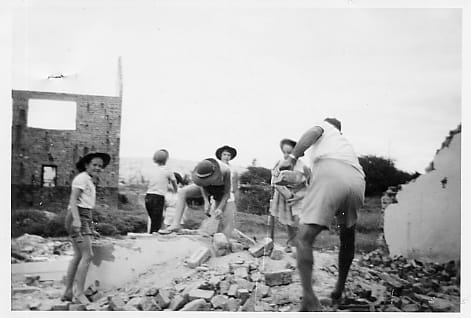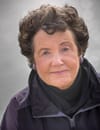It Takes a Villiage

Piper Moss Mine. Demolishing an old house donated by Mr. Varkevisser. Bricks were cleaned and transported on an old WWII ambulance to Echo Park at Dutchmans Pool
It Takes a Village.
I’ve written a lot about my parents and the contribution they made to developing Que Que from a paltry village to the industrial hub of Rhodesia. However, of course long before Hilary Clinton coined the phrase It Takes a Village Que Que knew the meaning of this all too well. For instance, this is how Echo Park came into being.
It Takes a Village
Around 1959, ten or so acres of beautifully wooded land with huge granite outcrops, splendid msasa trees, as well as a variety of other trees and shrubs and most importantly a fairly large flat area for campers, was donated to the Boy Scout and Girl Guide movements by Que Que Round Table. It was just eight miles out of town along a winding dirt road.
The Scouting and Guiding movements raised five hundred pounds towards development of the park, the dream being a Lodge for training purposes for Guiders from allover the Federation, and where Brownies and Cubs not yet old enough to camp could enjoy holidays. State Lotteries took a hand and agreed to loan one thousand pounds provided it be repaid. But the enthusiasm of the Guides, Brownies and Cubs and Scouts made the State Lotteries decide to give six thousand five hundred pounds as a grant. Fund raising from the pantomime The Magic Shoes raised sixty pounds. Subsequent pantos, the Aqua Follies and Nonsense Galas involved the whole town one way or another and continued for years.
Lady Baden-Powell, the World Chief Guide visited the Dutchman’s Pool site on her World Tour as well as Rhodesia’s National Commissioner Mrs. Wynn and her successor Mrs. Rae.
The Lions Club, whose young and enthusiastic members had youngsters in the movement, organized work parties to lay water and stand pipes. Ron Freeman, with his very pink knees, directed operations. In all, over time, as funds allowed, ten standpipes with municipal water were installed.
Mr. Varkevisser of the Piper Moss Mine gave a derelict building. It was demolished. The bricks were cleaned and stacked by the Guides and Brownies. Word went out for donation of abandoned doors, window frames, roof beams or piping.
Somewhere along the way the movement acquired an old WWII ambulance. Only Mrs. Elaine Tyzack and Mark Gilby knew how to get the gears to do what they were supposed to do. It was not licensed, chewed petrol and was not supposed to carry humans. The bricks and supplies were loaded into it and transported to Echo Park campground. The ambulance served well in all manner of ways.
Cubs and Brownies brought their own picnic lunches, and had great sessions rolling rocks and stones down from the hill to be carted away to what was to become the foundations of proper toilets and later on a brick shower house and pit toilets, as well as a caretaker’s cottage.
Surplus logs from the telephone or electricity department were supplied. There were enough to build a log cabin. Dave Morrison and his Scouts erected this cabin on the Scout Hall grounds, labeled each log and then transported them out to the site, before the next challenge of the roof installation from the donation of thousands of surplus red tiles from a building.
Beds with narrow iron bedsteads, that an African school had refused to buy, were moved in. Mattresses were made and covered with heavy plastic
A covered kitchen and washing up area followed in due course.
The multi racial weekend training facility had been realized. It also allowed the Brownies and Cubs to enjoy all the fun of the outdoors and the thrill of sleeping in a real log cabin.
The caretaker’s cottage was built near the entrance. The caretaker received weekly wages and rations. He fished in Dutchman’s Pool. On the sly he set snares.
Mom would lament over and over again “my heart is very sore,” as the snares were repeatedly discovered.
Finally splendid entrance gates of wrought iron were erected and a short brick wall built that went around a tree and ended up in a rocky outcrop, vivid with red aloes in the winter, which was the camping season. It was a beautiful area with the Sebakwe River nearby and baobab trees a short distance away along a winding path. Sable Game Park was developed adjoining it and later a beautiful stone fisherman’s tea- room.
In the 70’s, John Nee, as a young policeman in Gatooma, a small town forty miles from Que Que, captured a large python thirteen feet (4m +) long and a second half that that size that had got into a farmer’s chicken house, wrecking havoc. He rang Vic Jenkinson, Que Que’s then town mayor and architect of Que Que’s handsome new Civic Center at the top of Main Street. Vic drove to Gatooma in his Citroen DS20 and collected the snakes from John for release into Echo Park. He opened the sacks at the park and stood back with the caretaker prodding the sack. No problems as the first meter left the sack but when the second meter came out, the caretaker backed off and by the time the third meter came out he was trying to climb on his car.
Echo Park was as wild as the adjoining Sable Game Park that was later developed, a gem of a place to explore the great outdoors for all ages and races. It was available for a fee to church and youth groups as well. It had taken a village and more, a generous hand out from the National lottery to donations of used materials and willing hands young and old to realize the dream.
